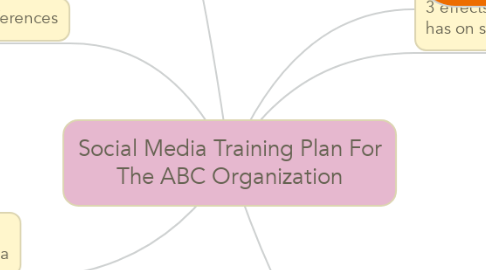
1. 3 ethical considerations of integrating social media
1.1. Create rules and regulations for the appropriate useage, this protects an organization's privacy, security and reputation
1.1.1. Accroding to Granado & Tsantes (2011), "Provide awareness training for staff members at all levels. Employees working in areas of particular vulnerability-whether to information assets or corporate reputation-should be well-briefed about data security and will need especially focused training."
1.1.1.1. According to Granado & Tsantes (2011), "Educate them about the basics, such as safeguarding and regularly updating passwords. In addition, implement processes to develop awareness and ensure compliance with security requirements. Encourage a collective understanding of the nature of informational and reputational risk, and gain employee support to help identify, manage and control that risk. It is equally important to lead by example. You are a role model, and your daily routine will guide appropriate mobile and networking behavior."
1.2. Make sure staff members have clear bounderies about sharing and posting personal information or negative comments.
2. 3 relevant training program competencies related to social media
2.1. According to Arneson, naughton & Rothwell (2013), "fostering a culture of connectivity and collaboration around learning via mobile and social technology." (ATD, 2013, ASTD launches para. 8).
2.1.1. According to Arneson, naughton & Rothwell (2013), "demonstrating the value and impact of learning by using metrics that are meaningful to business and using data analysis to measure the effectiveness and efficiency of learning and development."(ATD, 2013, ASTD launches para. 8).
2.1.1.1. According to Arneson, naughton & Rothwell (2013), " staying abreast of new and emerging technologies and matching the appropriate technology to a specific learning opportunity or challenge."(ATD, 2013, ASTD launches para. 8).
3. References
3.1. Sink, D. L. (2008). Section III: Designing and developing effective learning - chapter 10: Instructional design models and learning theories. Alexandria: Association for Talent Development. Retrieved from http://search.proquest.com/docview/896136435?accountid=458
3.1.1. Simon, B. S., & Ferguson, R. (2012). Social learning analytics. Journal of Educational Technology & Society, 15(3), 3-n/a. Retrieved from http://search.proquest.com/docview/1287025371?accountid=458
3.1.1.1. Granado, J., & Tsantes, G. ". (2011). Social media at work. CIO Insight, (115), 16. Retrieved from http://search.proquest.com/docview/856212155?accountid=458
3.2. Arneson, J., Naughton, J., & Rothwell, W. J., (2013). ASTD launches a revised competency model for the profession. Retrieved from https://www.td.org/Publications/Magazines/TD/TD-Archive/2013/01/Training-and-Development-Competencies-Redefined
4. Adult learning theories
4.1. Behaviorism- is centered on the notion of observable learning behavior and reinforcement. Task are put into baby steps (Sink, 2008).
4.1.1. Cognitivism- Focuses what internally happens when a person learns. (Sink, 2008).
4.1.1.1. Constructivism - Focuses on how knowledge and information is compiled by learner as they search to interpret new experiences. (Sink, 2008).
4.2. Behaviorism can be used to teach learners how to utilize social media tools and E-learning
4.2.1. Cognitivism can be used to provide learning guidance so learners can understand how social media works
4.2.1.1. Constructivism can be used to provide the opportunity to collaborate with others that are new to social media and E-learning
5. 3 effects of social media or e-learning has on student motivation
5.1. Provides a platform for collaboration via technology, no face-to-face contact is needed
5.1.1. Helps with self-learning by empowering the learner with the tools to learn autonomously
5.1.1.1. Fosters social learning via technology, social media and E-learning
5.1.1.1.1. Learners can share, post and echange information and ideas
